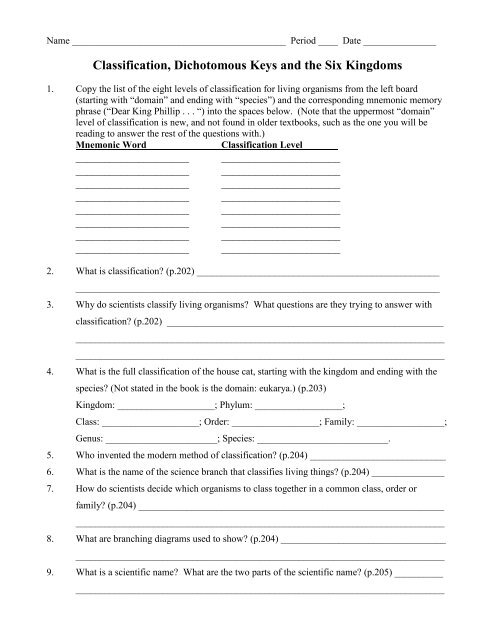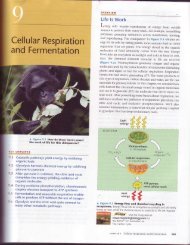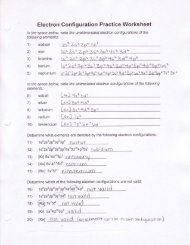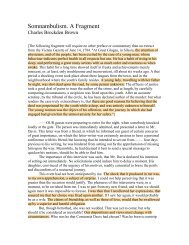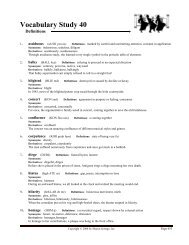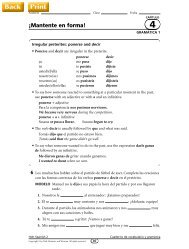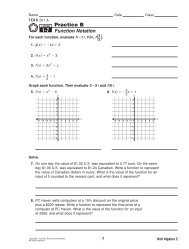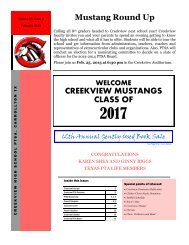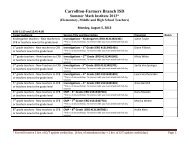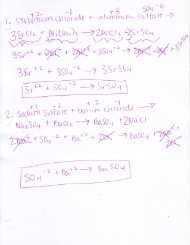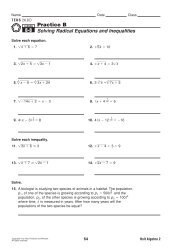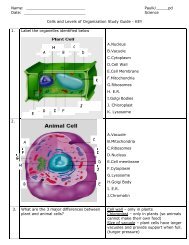Classification, Dichotomous Keys and the Six Kingdoms
Classification, Dichotomous Keys and the Six Kingdoms
Classification, Dichotomous Keys and the Six Kingdoms
You also want an ePaper? Increase the reach of your titles
YUMPU automatically turns print PDFs into web optimized ePapers that Google loves.
Name ____________________________________________ Period ____ Date _______________<br />
<strong>Classification</strong>, <strong>Dichotomous</strong> <strong>Keys</strong> <strong>and</strong> <strong>the</strong> <strong>Six</strong> <strong>Kingdoms</strong><br />
1. Copy <strong>the</strong> list of <strong>the</strong> eight levels of classification for living organisms from <strong>the</strong> left board<br />
(starting with “domain” <strong>and</strong> ending with “species”) <strong>and</strong> <strong>the</strong> corresponding mnemonic memory<br />
phrase (“Dear King Phillip . . . “) into <strong>the</strong> spaces below. (Note that <strong>the</strong> uppermost “domain”<br />
level of classification is new, <strong>and</strong> not found in older textbooks, such as <strong>the</strong> one you will be<br />
reading to answer <strong>the</strong> rest of <strong>the</strong> questions with.)<br />
Mnemonic Word <strong>Classification</strong> Level<br />
____________________ _____________________<br />
____________________ _____________________<br />
____________________ _____________________<br />
____________________ _____________________<br />
____________________ _____________________<br />
____________________ _____________________<br />
____________________ _____________________<br />
____________________ _____________________<br />
2. What is classification? (p.202) __________________________________________________<br />
___________________________________________________________________________<br />
3. Why do scientists classify living organisms? What questions are <strong>the</strong>y trying to answer with<br />
classification? (p.202) _________________________________________________________<br />
____________________________________________________________________________<br />
____________________________________________________________________________<br />
4. What is <strong>the</strong> full classification of <strong>the</strong> house cat, starting with <strong>the</strong> kingdom <strong>and</strong> ending with <strong>the</strong><br />
species? (Not stated in <strong>the</strong> book is <strong>the</strong> domain: eukarya.) (p.203)<br />
Kingdom: ____________________; Phylum: __________________;<br />
Class: ____________________; Order: __________________; Family: __________________;<br />
Genus: _______________________; Species: ___________________________.<br />
5. Who invented <strong>the</strong> modern method of classification? (p.204) ____________________________<br />
6. What is <strong>the</strong> name of <strong>the</strong> science branch that classifies living things? (p.204) _______________<br />
7. How do scientists decide which organisms to class toge<strong>the</strong>r in a common class, order or<br />
family? (p.204) _______________________________________________________________<br />
____________________________________________________________________________<br />
8. What are branching diagrams used to show? (p.204) __________________________________<br />
____________________________________________________________________________<br />
9. What is a scientific name? What are <strong>the</strong> two parts of <strong>the</strong> scientific name? (p.205) __________<br />
____________________________________________________________________________
10. How are scientific names always capitalized <strong>and</strong> written? (p.205) _______________________<br />
____________________________________________________________________________<br />
11. What is <strong>the</strong> scientific name of <strong>the</strong> dinosaur shown on p.205 (written with <strong>the</strong> proper<br />
capitalization <strong>and</strong> underlining)? __________________________________________________<br />
12. Why is it important for scientists to use scientific names? (p.206) _______________________<br />
____________________________________________________________________________<br />
13. What is a dichotomous key? (pp.206-07) __________________________________________<br />
____________________________________________________________________________<br />
14. Using <strong>the</strong> dichotomous key on p.207, identify <strong>the</strong> animal with <strong>the</strong> following traits: does not fly,<br />
has long, round (not flattened), naked (no fur) tail? ___________________________________<br />
15. Using <strong>the</strong> dichotomous key on p.207, identify <strong>the</strong> animal with <strong>the</strong> following traits: does not fly,<br />
has short, cottony, fur covered tail, long ears, not brown with white underbelly, has no black<br />
face mask, <strong>and</strong> does not have black fur with white stripes? _____________________________<br />
16. Using <strong>the</strong> branching diagram at <strong>the</strong> bottom of p.207, answer <strong>the</strong> following questions:<br />
a. Which plant is <strong>the</strong> closest relative of <strong>the</strong> hibiscus? ______________________________<br />
b. Which plant is most distantly related to <strong>the</strong> hibiscus? ___________________________<br />
c. Which plants have seeds? _________________________________________________<br />
17. Into what kingdom is <strong>the</strong> micro-organism called Euglena classified? (p.208) ______________<br />
What traits does Euglena share with animals? _______________________________________<br />
What traits does Euglena share with plants? ________________________________________<br />
Why <strong>the</strong>n is Euglena not classified as a plant or animal? ______________________________<br />
____________________________________________________________________________<br />
18. What are bacteria? (p.209) ______________________________________________________<br />
19. What are <strong>the</strong> two kingdoms of bacteria? (p.209) __________________ <strong>and</strong> _______________<br />
20. Which kingdom of bacteria often contains extremophiles? (p.209) _______________________<br />
21. What are <strong>the</strong> main identifying traits of protests? (p.210) _______________________________<br />
____________________________________________________________________________<br />
22. What are <strong>the</strong> main identifying traits of plants? (p.211) ________________________________<br />
____________________________________________________________________________<br />
23. What are <strong>the</strong> main identifying traits of fungi? (p.212) _________________________________<br />
____________________________________________________________________________<br />
24. What are <strong>the</strong> main identifying traits of animals? (p.213) _______________________________<br />
____________________________________________________________________________


